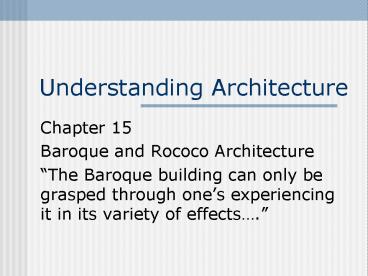Understanding Architecture - PowerPoint PPT Presentation
Title:
Understanding Architecture
Description:
Understanding Architecture Chapter 15 Baroque and Rococo Architecture The Baroque building can only be grasped through one s experiencing it in its variety of ... – PowerPoint PPT presentation
Number of Views:271
Avg rating:3.0/5.0
Title: Understanding Architecture
1
Understanding Architecture
- Chapter 15
- Baroque and Rococo Architecture
- The Baroque building can only be grasped through
ones experiencing it in its variety of effects.
2
Baroque Architecture
- Whereas Renaissance architecture gave the visual
impression of being simple, Baroque architecture
was deliberately complex - Instead of clarity there was conflict
- Instead of uniformity of the elements and overall
effect, there was studied variety - Instead of regularity, there was contrast
3
Baroque Architecture
- During the Renaissance there had been planar
forms with an emphasis on the surface, the
Baroque emphasis was on plasticity and spatial
depth - Renaissance was human in scale Baroque became
superhuman in scale - Renaissance stressed easily perceived forms
Baroque projected a sense of mystery
4
Baroque Architecture
- Renaissance, the interest was in
intellectural comprehension and cerebral
satisfaction in Baroque, it shifted to creating
an emotional impact - The term baroque was used to denigrate the
architecture of 17th and 18th century
architecture and was derived from the Portugese
term for misshapen pearl barocco
5
Baroque Architecture
- The reasons for the shift toward visual
complexity are several - During any period of artistic creativity, where
the goal is to reach absolute balance, once the
goal is reached, a reaction sets in - The Counter Reformation of the Catholic Church
reacted to the tenets of the Protestant
Reformation, eg. the Church insisted that music,
painting, sculpture and architecture, when
properly handled, were among the most powerful
instruments enhancing religious devotion
6
Jesuits Counter-reformation
- The original countries that initiated the Baroque
style remained faithful to the Catholic church
after the reformation - The Jesuits enlisted the leading figure of the
Baroque movement for their projects - The exciting forms in the Baroque style was used
for the purpose of religion
7
1st breakaway point from the Renaissance
- Unquestionably dramatic
- Asymmetrical
- Experimentation with new and dynamic massing
8
2nd breakaway point from the Renaissance
- Employed swirling S-curves and shapes that
represents movement - Deserted the static form of the square and circle
- Undulating facades and plans based on the oval
shape - The Council of Trent decalred the square and
circle as too pagan for Christian Churches (1545)
9
3rd breakaway point from the Renaissance
- Baroque had an extreme form of theatricality
which involved the creation of illusion - Trompe-loeil
- Music Room, Chatsworth Derbyshire
- Harewood House
10
Baroques Intention
- Brunelleschi and Bramantes concern in adhering
to the standards set in the renaissance is of no
concern for Bernini and Borrominis baroque - It seeks to carry the audience away with emotion
- No pedantic desire to teach
- No moralistic desire to judge against standards
11
Giacomo della Porta Façade of the Gesu 1573-77
12
Church of Saints Vincent and Anastasius
13
Sacristy of La Cartuja Granada, Spain
14
Cornaro Chapel, Santa Maria della Vittoria, Rome
1657-52
15
Berninis Ecstasy of St. Theresa 1646
- Staged a little play with his sculpture
- Members of the Cornaro family watching the scene
16
Altar of the Priory Church of the Assumption
Rohr, Germany
17
(No Transcript)
18
omp
St John Nepomuk, Munich, 1733-46 Egid Quirin Asam
Thirty feet wide With swirling balconies, twisted
pillars Throbbing in gold, dark browns and red
19
Window over the high altar in St John Nepomuk
20
St John Nepomuk, Munich, 1733-46 Exterior
21
Church of Sant Andrea al Quirinale, Rome 1658-70
22
Church of Sant Andrea al Quirinale
23
Piazzo of Saint Peters Rome, Bernini, 1656-67
24
San Carlo alle Quattro Fontane, Rome 1634-67
25
San Carlo alle Quattro Fontane
26
Sant Ivo della Sapienza
27
Guarini, Santa Maria della Divina Providenza,
Lisbon, Portugal, 1652-63 (destroyed 1755)
28
Neumann, Prince-Bishops Palace, Würzburg,
Germany 1737-42
29
Prince-Bishops Palace, Würzburg
30
Amalienburg Pavilion, Nymphenburg Palace, Munich
1734-39
31
Vierzehnheiligen, Plan
http//www.vierzehnheiligen.de/fr_rundum.htm
32
Vierzehnheiligen
33
Baroque Architecture Conclusion
- In their striving for the fullest possible
effects of molded space, manipulated light,
brilliant colour, and sensuous detail, Baroque
and later Rococo, was concerned predominantly
with the shaping of space and not with the
fundamental structure of architecture































